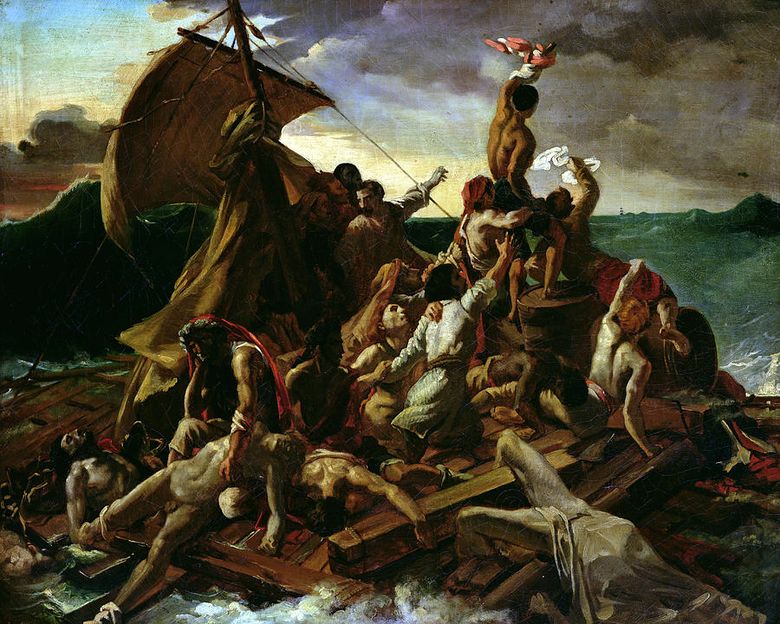
In July 1816, the frigate of the Royal Navy “Medusa” crashes off the west coast of Africa. A young and inexperienced captain leaves one hundred and forty-nine men on a raft that drifts on the sea for thirteen days. One hundred and thirty-four people die of cold, hunger and thirst.
The human tragedy, which depicts Gericault, captures him completely; he seeks to create her true image. This basic desire of Gericault dictates to him the choice of composition, its character, all the innovations that it introduces. In an effort to build a scene with the greatest dramatic realism, Gericault is compelled to reject the favored frontal structure at that time and comes to his deep, intense, dynamic composition.
“The Raft of Medusa” is perceived not as an episode, but as an epic; the picture clearly outgrows its plot, it becomes a symbol of the tragic struggle of man with a hostile element, the personification of immeasurable suffering, heroic tensions and impulse. Hence the generalized style of Gericault – Laconic, avoiding minor effects, focusing on the whole. Despite the wealth of contradictory episodes from which the composition is composed, they are not perceived as anything self-sufficient, but as a subordinate whole.
“Raft of Medusa” – with all the boiling of human suffering – grows like a monolith like a single sculpted group. This is the first thing that is perceived, that is permanently imprinted in the memory of the viewer, taking with him a dramatically rich, exceptional in strength image…
The variety of the depicted positions and experiences does not lead to fragmentation of the composition, but is reduced to unity, creating a clear, memorable image of events, and this unity is not achieved by mechanical methods of equilibrium, as was the case at David’s school.
Gericault perceives reality first of all, space-plastic. To enhance the spatial effect of the scene, he has a raft diagonally crowded with people, chooses a high point of view: this gives him the opportunity to show the contradictory variety of events with the greatest naturalness, express the whole range of feelings – from the passive despair of his father, numb over the corpse of his son, to an active struggle with the elements and a distrustful and shy hope for salvation… The romantic sound of the canvas is achieved thanks to the color, as well as the play of light and shade. Gericault was guided here by the paintings of Caravaggio and the paintings of the Sistine Chapel of Michelangelo.
Gericault exhibits this powerful seven-meter canvas at the Salon of 1819, and it immediately turns out to be the focus of public attention. The reaction of his contemporaries was unexpected for the author himself. Governmental circles of France and the official press dubbed the painter a “dangerous rebel”, and the historian Michelet explained why: “This is France itself, this is our society immersed on the raft of Medusa” …
 Raft of the Medusa by Teodor Gericault
Raft of the Medusa by Teodor Gericault Portrait of a Madman by Theodore Gericault
Portrait of a Madman by Theodore Gericault The furnace for calcining gypsum by Theodore Gericault
The furnace for calcining gypsum by Theodore Gericault Officer of the horse rangers of the Imperial Guard, going on the attack by Theodore Gericault
Officer of the horse rangers of the Imperial Guard, going on the attack by Theodore Gericault Balsa Medusa – Theodore Gericault
Balsa Medusa – Theodore Gericault Radeau de Méduse – Theodore Gericault
Radeau de Méduse – Theodore Gericault Five horses, rotated by groats, in the stables by Theodore Gericault
Five horses, rotated by groats, in the stables by Theodore Gericault The head of a white horse by Theodore Gericault
The head of a white horse by Theodore Gericault